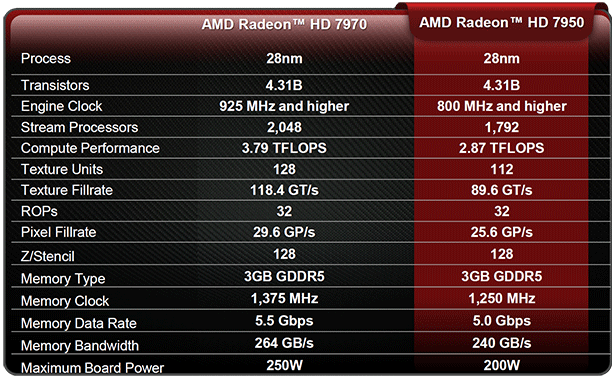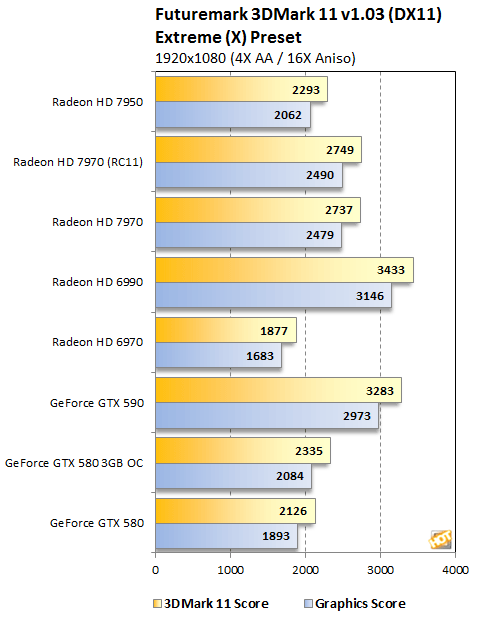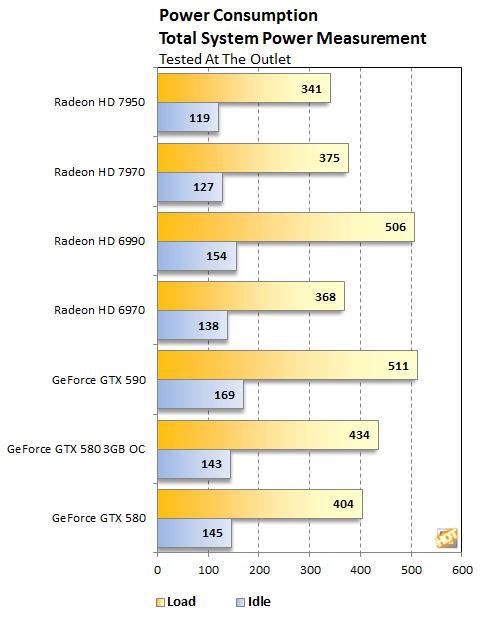When AMD announced the Radeon HD 7970 last month, it revealed a new, ultra-powerful graphics card that snatched the single-GPU performance crown from the previous titleholder, NVIDIA’s GeForce GTX 580. AMD may have staked a claim for the fastest single graphics card with the dual-GPU powered Radeon HD 6990, but its previous flagship single-GPU powered card, the Radeon HD 6970, generally trailed the GeForce GTX 580 in real-world game performance.
Although the Radeon HD 7970 didn’t actually go on sale until a few weeks after the initial announcement, there was no doubt it would be the highest performing single-GPU based graphics card available when it finally did arrive, based on early testing. What we didn’t know was how its little brother, the Radeon HD 7950 would fare. At the time of the Radeon HD 7970’s announcement, we knew the Radeon HD 7950 would be based on the same GPU and that it would arrive a few weeks after the 7970, but its final specifications and price point hadn’t been disclosed.
As it turns out, we’ve had a couple of the cards in-house for a little while now and can finally reveal all of the juicy details. AMD has also provided a fresh set of drivers which reportedly enhance the performance of the 7900-Series cards, so we recorded another set of scores with the 7970 using the updated drivers to show how much additional performance AMD was able to wring out of its newest GPU in the few weeks since we last took a look at it.
First up, some specifications and pictures of the newly released Radeon HD 7950, followed by full set of numbers for the rabbid PC gamers among you—which we assume is everyone reading this.
BY: http://hothardware.com/Reviews/AMD-Radeon-HD-7950-Tahiti-Pro-GPU-Review/?page=1
Although the Radeon HD 7970 didn’t actually go on sale until a few weeks after the initial announcement, there was no doubt it would be the highest performing single-GPU based graphics card available when it finally did arrive, based on early testing. What we didn’t know was how its little brother, the Radeon HD 7950 would fare. At the time of the Radeon HD 7970’s announcement, we knew the Radeon HD 7950 would be based on the same GPU and that it would arrive a few weeks after the 7970, but its final specifications and price point hadn’t been disclosed.
As it turns out, we’ve had a couple of the cards in-house for a little while now and can finally reveal all of the juicy details. AMD has also provided a fresh set of drivers which reportedly enhance the performance of the 7900-Series cards, so we recorded another set of scores with the 7970 using the updated drivers to show how much additional performance AMD was able to wring out of its newest GPU in the few weeks since we last took a look at it.
First up, some specifications and pictures of the newly released Radeon HD 7950, followed by full set of numbers for the rabbid PC gamers among you—which we assume is everyone reading this.
BY: http://hothardware.com/Reviews/AMD-Radeon-HD-7950-Tahiti-Pro-GPU-Review/?page=1
AMD Radeon HD 7950 DirectX 11 Graphics Card
|

As we’ve mentioned, the new Radeon HD 7950 is based on the same GPU found at the heart of the Radeon HD 7970, codenamed Tahiti. The chip, which is based on a totally new architecture dubbed GCN or Graphics Core Next, is manufactured using TSMC’s 28nm process and features a whopping 4.31B (that’s billion) transistors. In its full configuration, which is found on the Radeon HD 7970, the Tahiti GPU sports 2,048 stream processors with 128 texture units and 32 ROPs. On the Radeon HD 7950, however, a few segments of the GPU have been disabled, resulting in a total of 1,792 active stream processors, with 112 texture units and 32 ROPs.
The Radeon HD 7950 is also clocked somewhat lower than the 7970, although AMD has claimed the cards are highly overclockable (which we test a little later). Whereas the Radeon HD 7970’s GPU is clocked at 925MHz (according to reference specifications), the 7950’s GPU is clocked at 800MHz. With fewer stream processors and texture units, and a lower frequency, the Radeon HD 7950’s compute performance has been reduced to 2.87 TFLOPS (vs. 3.79 TFLOPS with the 7970), with texture and pixel fillrates of the 89.6GT/s and 25.6GP/s, respectively, versus 118.4GT/s and 29.6GP/s for the 7970.
The Radeon HD 7950 and 7970 share the same sized 3GB frame buffer, which connects to the GPU via the same 384-bit interface, but the memory of the 7950 is clocked lower than the 7970’s as well; 1,250MHz vs. 1,375MHz, resulting in peak memory bandwidth of 240GB/s on the Radeon HD 7950.
Although their specifications are somewhat different, because they are based on the same GPU, the Radeon HD 7970 and 7950 have identical feature sets, which include AMD’s ZeroCore Power Technology, Discrete Digital Multi-Point Audio, PowerTune, GCN, Eyefinity, Partially Resident Textures (PRT), and more. We have already covered all of the low-level technical details in our Radeon HD 7970 launch article, however, so we won’t rehash everything again here. If, however, you’d like a refresher on the technology, we’d strongly suggest giving this article a read.
The Radeon HD 7950 is also clocked somewhat lower than the 7970, although AMD has claimed the cards are highly overclockable (which we test a little later). Whereas the Radeon HD 7970’s GPU is clocked at 925MHz (according to reference specifications), the 7950’s GPU is clocked at 800MHz. With fewer stream processors and texture units, and a lower frequency, the Radeon HD 7950’s compute performance has been reduced to 2.87 TFLOPS (vs. 3.79 TFLOPS with the 7970), with texture and pixel fillrates of the 89.6GT/s and 25.6GP/s, respectively, versus 118.4GT/s and 29.6GP/s for the 7970.
The Radeon HD 7950 and 7970 share the same sized 3GB frame buffer, which connects to the GPU via the same 384-bit interface, but the memory of the 7950 is clocked lower than the 7970’s as well; 1,250MHz vs. 1,375MHz, resulting in peak memory bandwidth of 240GB/s on the Radeon HD 7950.
Although their specifications are somewhat different, because they are based on the same GPU, the Radeon HD 7970 and 7950 have identical feature sets, which include AMD’s ZeroCore Power Technology, Discrete Digital Multi-Point Audio, PowerTune, GCN, Eyefinity, Partially Resident Textures (PRT), and more. We have already covered all of the low-level technical details in our Radeon HD 7970 launch article, however, so we won’t rehash everything again here. If, however, you’d like a refresher on the technology, we’d strongly suggest giving this article a read.
As you can see in the pictures, the Radeon HD 7950 is basically identical to the higher-end 7970 (the only physical differences are their power connectors). There is a single, barrel type fan at the rear of the card, which pumps air through a heatsink with vapor chamber, which is in turn expelled through vents in the case bracket. That’s how previous Radeon HD 6900 series cards were configured as well, but with the 7970 and 7950, AMD has moved to a new fan design with larger, wider blades. The fan has been optimized for lower speed operation, but pushes more air than the previous generation. AMD also removed the stacked DVI connector present on 6900-series cards to increase the size of the exhaust vent and reduce turbulence. The Radeon HD 7970 and 7950 are also outfitted with a multi-step vapor chamber with three distinct levels. One level makes contact with the GPU, another with the memory, and the last touches the VREGs.
The fan shroud design on the 7900-Series has been tweaked as well. Unlike Radeon HD 6900 series cards which had a mostly squared, flat design that was sealed at the rear, the Radeon HD 7970 and 7950 have curved shrouds with additional vents. AMD also removed the stiffening plate from the back to maximize the amount of air-space that would be present between cards installed in adjacent PEG slots. A second-generation phase-change thermal interface material is used as well. All of these changes (along with the move to 28nm) culminate in significantly reduced temperatures over older Radeons, although the updated cooler has proven to be somewhat louder than the fansink combo used on the Radeon HD 6970.
Other physical attributes of the Radeon HD 7950 include the familiar pair of CrossFire edge connectors at the top, and the two-position BIOS switch that debuted on Radeon HD 6900 series cards. That tiny switch is used to toggle between two BIOS chips on the card—the first BIOS can be altered / updated, while the second will return the card to its factory settings (or vice versa). That’s something that might come in handy with the modding crowd, which are likely to be fond of the 7950.
Also on the top, at the far end of the card are its power connectors. Unlike the Radeon HD 7970 which requires a PCIe 8-pin feed along with a 6-pin feed, the Radeon HD 7950 has a pair of 6-pin connectors only.
Finally, the output configuration on reference Radeon HD 7950 series cards consists of one dual-link DVI output, two mini-DisplayPort outputs and a single HDMI output. Four of these outputs can be used at any given time to power displays in a multi-monitor Eyefinity configuration, but with upcoming DisplayPort hubs due to arrive in shortly, up to six displays can be connected to a single card.
The fan shroud design on the 7900-Series has been tweaked as well. Unlike Radeon HD 6900 series cards which had a mostly squared, flat design that was sealed at the rear, the Radeon HD 7970 and 7950 have curved shrouds with additional vents. AMD also removed the stiffening plate from the back to maximize the amount of air-space that would be present between cards installed in adjacent PEG slots. A second-generation phase-change thermal interface material is used as well. All of these changes (along with the move to 28nm) culminate in significantly reduced temperatures over older Radeons, although the updated cooler has proven to be somewhat louder than the fansink combo used on the Radeon HD 6970.
Other physical attributes of the Radeon HD 7950 include the familiar pair of CrossFire edge connectors at the top, and the two-position BIOS switch that debuted on Radeon HD 6900 series cards. That tiny switch is used to toggle between two BIOS chips on the card—the first BIOS can be altered / updated, while the second will return the card to its factory settings (or vice versa). That’s something that might come in handy with the modding crowd, which are likely to be fond of the 7950.
Also on the top, at the far end of the card are its power connectors. Unlike the Radeon HD 7970 which requires a PCIe 8-pin feed along with a 6-pin feed, the Radeon HD 7950 has a pair of 6-pin connectors only.
Finally, the output configuration on reference Radeon HD 7950 series cards consists of one dual-link DVI output, two mini-DisplayPort outputs and a single HDMI output. Four of these outputs can be used at any given time to power displays in a multi-monitor Eyefinity configuration, but with upcoming DisplayPort hubs due to arrive in shortly, up to six displays can be connected to a single card.
How We Configured Our Test Systems: We tested the graphics cards in this article on an Asus P9X79 Deluxe motherboard powered by a Core i7-3960X six-core processor and 16GB of G.SKILL DDR3-1600 RAM. The first thing we did when configuring the test system was enter the system UEFI and set all values to their "optimized" or "high performance" default settings and disabled any integrated peripherals that wouldn't be put to use. The hard drive was then formatted and Windows 7 Ultimate x64 was installed. When the installation was complete we fully updated the OS and installed the latest DirectX redist, along with the necessary drivers, games, and benchmark applications.
|
| Hardware Used: Intel Core i7-3960X (3.3GHz, Six-Core) Asus P9X79 Deluxe (Intel X79 Express) Radeon HD 7950 Radeon HD 7970 Radeon HD 6990 Radeon HD 6970 GeForce GTX 590 GeForce GTX 580 3GB OC GeForce GTX 580 16GB OCZ DDR3-1600 Western Digital Raptor 150GB Integrated Audio Integrated Network | Relevant Software: Windows 7 Ultimate x64 DirectX April 2011 Redist ATI Catalyst v12.1b/12.2 NVIDIA GeForce Drivers 290.53 Benchmarks Used: Unigine Heaven v2.5 3DMark 11 Batman: Arkham City Just Cause 2 Alien vs. Predator Metro 2033 Lost Planet 2 Dirt 3 |
|
 Unigine Heaven | Unigine's Heaven Benchmark v2.5 is built around the Unigine game engine. Unigine is a cross-platform, real-time 3D engine, with support for DirectX 9, DirectX 10, DirectX 11 and OpenGL. The Heaven benchmark--when run in DX11 mode--also makes comprehensive use of tessellation technology and advanced SSAO (screen-space ambient occlusion) It also features volumetric cumulonimbus clouds generated by a physically accurate algorithm and a dynamic sky with light scattering. |


Also note the marked improvement in the 7970's performance when using the latest RC11 drivers, versus our original scores from last month.
|
 Futuremark 3DMark11 | The latest version of Futuremark's synthetic 3D gaming benchmark, 3DMark11, is specifically bound to Windows Vista and WIndows 7-based systems due to its DirectX 11 requirement, which isn't available on previous versions of Windows. 3DMark11 isn't simply a port of 3DMark Vantage to DirectX 11, though. With this latest version of the benchmark, Futuremark has incorporated four new graphics tests, a physics tests, and a new combined test. We tested the graphics cards here with 3DMark11's Extreme preset option, which uses a resolution of 1920x1080 with 4x anti-aliasing and 16x anisotropic filtering. |

The Radeon HD 7950 also performed well in the 3DMark11 benchmark. Here, the 7950 finished behind the Radeon HD 7970, but fell somewhere in between the reference GeForce GTX 580 and the factory overclocked 3GB model.
Once again, we see a small performance improvement for the Radeon HD 7970 when tested with the newer RC11 drivers.
Before bringing this article to a close, we'd like to cover a few final data points--namely power consumption and noise. Throughout all of our benchmarking and testing, we monitored acoustics and tracked how much power our test system was consuming using a power meter. Our goal was to give you an idea as to how much power each configuration used while idling and while under a heavy workload. Please keep in mind that we were testing total system power consumption at the outlet here, not just the power drawn by the graphics cards alone.
| |
|



Tidak ada komentar:
Posting Komentar